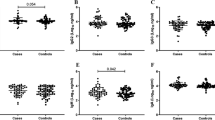Abstract
Trichomoniasis, caused by the protozoan parasite Trichomonas vaginalis, is a major nonviral sexually transmitted disease. Clinical spectrum varies from an asymptomatic state to mild, moderate, or severe symptoms. However, the exact factors leading to the variations in symptoms have not been well elucidated. Host’s immune response to the parasite may be playing a role in varied symptomatology. The present study reports antitrichomonas IgM, IgA, IgG and its subclasses in doubling dilutions of serum and diluted vaginal washes of six T. vaginalis-infected symptomatic and four T. vaginalis-infected asymptomatic women and uninfected controls by enzyme-linked immunosorbent assay (ELISA). No significant difference was observed in serum IgG ELISA absorbance values from symptomatic compared to asymptomatic subjects (p > 0.05) while a significant difference (p < 0.05) was noted in serum IgM in all the tested dilutions and IgA up to a dilution of 400. This is the first report of the detection of specific IgG subclass response in T. vaginalis-infected female patients, and quantitative analysis of the antibody responses indicated that the production of local IgG particularly IgG1 in vaginal secretions may be playing a significant role in establishing symptomatic infection. The interesting observation of the present study is that the specific IgM was detected in 2 (33.3%) symptomatic and T. vaginalis-infected patients in ≥800 dilutions and in 1 (16.6%) up to 200 dilutions in serum, while it was not detectable in the vaginal secretions of symptomatic patients or in the serum and vaginal secretions of asymptomatic T. vaginalis-infected patients.
Similar content being viewed by others
References
Ackers JP, Lumsden WH, Catterall RD, Coyle R (1975) Antitrichomonal antibody in the vaginal secretions of women infected with T. vaginalis. Br J Vener Dis 51:319–323
Alderete JF, Newton E, Dennis C, Neale KA (1991) Antibody in sera of patients infected with Trichomonas vaginalis is to trichomonad proteinases. Genitourin Med 67:331–334
Alderete JF, Wendel KA, Rompalo AM, Erbelding EJ, Benchimol M, Chang TH (2003) Trichomonas vaginalis: evaluating capsid proteins of dsRNA viruses and the dsRNA virus within patients attending a sexually transmitted disease clinic. Exp Parasitol 103:44–50
Arroyo R, Gonzalez-Robles A, Martinez-Palomo A, Alderete JF (1993) Signalling of Trichomonas vaginalis for amoeboid transformation and adhesion synthesis follows cytoadherence. Mol Microbiol 7:299–309
Chipperfield EJ, Evans BA (1972) The influence of local infection on immunoglobulin formation in the human endocervix. Clin Exp Immunol 11:219–233
Engbring JA, Alderete JF (1998) Characterization of Trichomonas vaginalis AP33 adhesin and cell surface interactive domains. Microbiology 144:3011–3018
Garcia LS (2007) Diagnostic medical parasitology, 5th edn. ASM, Washington, DC
Kaul P, Gupta I, Sehgal R, Malla N (2004) Trichomonas vaginalis: random amplified polymorphic DNA analysis of isolates from symptomatic and asymptomatic women in India. Parasitol Int 53:255–262
Khoshnan A, Alderete JF (1994) Trichomonas vaginalis with a double-stranded RNA virus has upregulated levels of phenotypically variable immunogen mRNA. J Virol 68:4035–4038
Lowry OH, Rosenbrough NJ, Farr AL, Randall RJ (1951) Protein measurement with the folin phenol reagent. J Biol Chem 193:265–275
Malla N, Valadkhan Z, Harjai K, Sharma S, Gupta I (2004) Reactive nitrogen intermediates in experimental trichomoniasis induced with isolates from symptomatic and asymptomatic women. Parasitol Res 94:101–105
Mendoza-Lopez MR, Becerril-Garcia C, Fattel-Facenda LV, Avila-Gonzalez L, Ruiz-Tachiquin ME, Ortega-Lopez J et al (2000) CP30, a cysteine proteinase involved in Trichomonas vaginalis cytoadherence. Infect Immun 68:4907–4912
Sharma P, Malla N, Gupta I, Ganguly NK, Mahajan RC (1991a) Anti-trichomonad IgA antibodies in trichomoniasis before and after treatment. Folia Microbiol (Prague) 36:302–304
Sharma P, Malla N, Gupta I, Ganguly NK, Mahajan RC (1991b) A comparison of wet mount, culture and enzyme linked immunosorbent assay for the diagnosis of trichomoniasis in women. Trop Geogr Med 143:257–260
Street DA, Taylor-Robinson D, Ackers JP, Hanna NF, McMillan A (1982) Evaluation of an enzyme-linked immunosorbent assay for the detection of antibody to Trichomonas vaginalis in sera and vaginal secretions. Br J Vener Dis 58:330–333
Su KE (1982) Antibody to Trichomonas vaginalis in human cervicovaginal secretions. Infect Immun 37:852–857
Swygard H, Sena AC, Hobbs MM, Cohen MS (2004) Trichomoniasis: clinical manifestations, diagnosis and management. Sex Transm Infect 80:91–95
Valadkhan Z, Sharma S, Harjai K, Gupta I, Malla N (2003) In vitro comparative kinetics of adhesives and haemolytic potential of T. vaginalis isolates from symptomatic and asymptomatic females. Indian J Pathol Microbiol 46:693–699
Wos SM, Watt RM (1986) Immunoglobulin isotypes of anti-Trichomonas vaginalis antibodies in patients with vaginal trichomoniasis. J Clin Microbiol 24:790–795
Yadav M, Gupta I, Malla N (2005) Kinetics of immunoglobulin G, M, A and IgG subclass responses in experimental intravaginal trichomoniasis: prominence of IgG1 response. Parasite Immunol 27:461–467
Yadav M, Dubey ML, Gupta I, Malla N (2006) Nitric oxide radicals in leucocytes and vaginal washes of Trichomonas vaginalis-infected symptomatic and asymptomatic women. Parasitology 132:339–343
Yi MR, Shin MH, Leem MH, Ryu JS, Ahn MH, Min DY (1990) Detection of IgG and IgM antibodies with ELISA technique in human trichomoniasis. Kisaengchunghak Chapchi 28:25–30
Author information
Authors and Affiliations
Corresponding author
Rights and permissions
About this article
Cite this article
Kaur, S., Khurana, S., Bagga, R. et al. Antitrichomonas IgG, IgM, IgA, and IgG subclass responses in human intravaginal trichomoniasis. Parasitol Res 103, 305–312 (2008). https://doi.org/10.1007/s00436-008-0971-y
Received:
Accepted:
Published:
Issue Date:
DOI: https://doi.org/10.1007/s00436-008-0971-y




